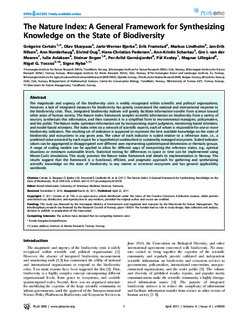| dc.description.abstract | The magnitude and urgency of the biodiversity crisis is widely recognized within scientific and political organizations. However, a lack of integrated measures for biodiversity has greatly constrained the national and international response to the biodiversity crisis. Thus, integrated biodiversity indexes will greatly facilitate information transfer from science toward other areas of human society. The Nature Index framework samples scientific information on biodiversity from a variety of sources, synthesizes this information, and then transmits it in a simplified form to environmental managers, policymakers, and the public. The Nature Index optimizes information use by incorporating expert judgment, monitoring-based estimates, and model-based estimates. The index relies on a network of scientific experts, each of whom is responsible for one or more biodiversity indicators. The resulting set of indicators is supposed to represent the best available knowledge on the state of biodiversity and ecosystems in any given area. The value of each indicator is scaled relative to a reference state, i.e., a predicted value assessed by each expert for a hypothetical undisturbed or sustainably managed ecosystem. Scaled indicator values can be aggregated or disaggregated over different axes representing spatiotemporal dimensions or thematic groups. A range of scaling models can be applied to allow for different ways of interpreting the reference states, e.g., optimal situations or minimum sustainable levels. Statistical testing for differences in space or time can be implemented using Monte-Carlo simulations. This study presents the Nature Index framework and details its implementation in Norway. The results suggest that the framework is a functional, efficient, and pragmatic approach for gathering and synthesizing scientific knowledge on the state of biodiversity in any marine or terrestrial ecosystem and has general applicability worldwide. | no_NO |
